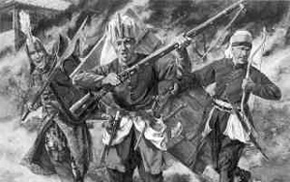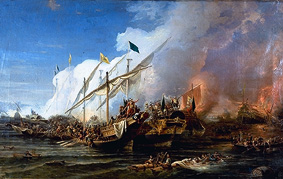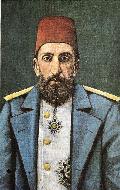- Articles Index
- Monthly Features
- General History Articles
- Ancient Near East
- Classical Europe and Mediterranean
- East Asia
- Steppes & Central Asia
- South and SE Asia
- Medieval Europe
- Medieval Iran & Islamic Middle East
- African History (-1750)
- Pre-Columbian Americas
- Early Modern Era
- 19'th Century (1789-1914)
- 20'th Century
- 21'st Century
- Total Quiz Archive
- Access Account
The Ottoman Empire
By Spitfire VII
Rise to Power
Murad I conquerored Thrace, Northwest of Constantinople and moved his capital to Edrine, formally Adrianople. This conquest effectively cut Constantinople from the outside world and sealed the fate of the Byzantines forever. Edrine also gave the Ottomans routes of invasion towards the north alowing the Ottomans to continue to expand their lands. During Murad's last victories aginst the Balkan Allies he was killed. His successor, Bayezid I (ruled 1389-1402), was unable to make further European conquests. He was forced to devote his attention to eastern Asia Minor to deal with a growing Turkish principality, Karaman. He attacked and defeated Karaman in 1391, put down a revolt of his Balkan subjects, and returned to consolidate his gains in Asia Minor. His successes attracted the attention of Timur Lenk (Tamerlane). Encouraged by Turkish princes who had fled to his court from Bayezid I's incursions, Timur Lenk attacked and overwhelmed him in 1402. Taken captive by Timur Lenk, Bayezid died within a year.
Timur Lenk soon retired leaving Bayezid's sons to do what thier father could not, expand and strengthen the empire. The four sons fought till Mohammed I killed the other three and took control. He reigned from 1413 to 1421 and his successor, Murad II, from 1421 to 1451. Murad II suppressed Balkan resistance and eliminated all but two of the Turkish principalities in Asia Minor. The task of finishing the Balkan conquests and seizing all of Asia Minor fell to Murad II 's successor, Mohammed II (ruled 1451-81). It was he who completed the siege of Constantinople in 1453 and made it the capital of the Ottoman Empire. The whole Balkan Peninsula south of Hungary was incorporated as well as the Crimea on the north coast of the Black Sea. Asia Minor was completely subdued.In addition to conquering a large empire, Mohammed II worked strenuously for consolidation and an adequate administrative and tax system.
He was assisted by the fact that the whole Byzantine bureaucratic structure fell into his hands. Although Islamic, Ottoman sultans were not averse to using whatever talent they could attract or capture.
The Golden Age
Three Sultans rueld during the Empire's Golden Age; Bayezid II (1481-1512), Selim I (1512-20), and Suleyman I the Magnificent (1520-66). Bayezid expanded the Empire in the Balkans and made outposts along the Black Sea, he also put down the revolts in Anatolia. He also turned the Ottoman Fleet into a major power, the navy was greatly expanded and Eastern and Byzantine influences were put together to make an effective fleet. Later in his life he was displaced by his more militant son, Selim I....
Selim first defeated all opposition to his position, he killed many of his advisories and even all but one of his sons! He established control over the army also, which wanted to raise it's own canidate.
During his shrot but expansionistic rule the Emprie expanded into Syria, Mesopotamia, Arabia and Egypt. Selim became the leader of the Islamic religion through his rule of Mecca and the Holy Places in Arabia and elsewhere. Another benefit of his rule was his effort to control the Trade Lines heading East-West. This forced European countries to seek ways through Afrika and partly the Ottoman Empire is responsible for forcing Europe into the discovery of the Americas....
Selim I's surviving son, Süleyman, came to the throne in an enviable situation. New revenues from the expanded empire left him with wealth and
In 1529 he laid siege to Vienna, Austria, but was forced to withdraw for lack of supplies. He also waged three campaigns against Persia. Algiers in North Africa fell to his navy in 1529 and Tripoli (now Libya) in 1551. The Ottoman Empire under Süleyman had reached it's hieght but it lasted only for a short while.... Decline of the Ottoman Sultanate
In 1571 the combined fleets of Venice, Spain, and the Papal States of Italy defeated the Turks in the great naval battle of Lepanto, off the coast of Greece. This defeat, which dispelled the myth of the invincible Turk, took place during the reign of Selim II (ruled 1566-74). But the empire rebuilt its navy and continued to control the eastern Mediterranean for another century.
The Central Government became weaker and large parts of the empire acted independently. The army was still strong enough, however, to prevent provincial rebels from asserting complete control. Under Murad III (ruled 1574-95) new campaigns were undertaken. The Caucasus was conquered, and Azerbaijan was seized. This brought the empire to the peak of its territorial extent. Reform efforts undertaken by 17th-century sultans did little to deter the onset of decay. The Ottomans were driven out of the Caucasus and Azerbaijan in 1603 and out of Iraq in 1604.
Iraq was retaken by Murad IV (ruled 1623-40) in 1638, but Iran remained a persistent military threat in the east. A war with Venice (1645-69) exposed Constantinople to an attack by the Venetian navy. In 1683 the last attempt to conquer Vienna failed. Russia and Austria fought the empire by direct military attack and by fomenting revolt by non-Muslim subjects of the sultan.
Beginning in 1683, with the attack on Vienna, the Ottomans were at war with European enemies for 41 years. As a result, the empire lost much of its Balkan territory and all the possessions on the shores of the Black Sea. In addition, the Austrians and Russians were allowed to intervene in the empire's affairs on behalf of the sultan's Christian subjects.
Selim III(ruled 1789-1807) attempted to reform and improve the Army but was overthrown and killed by the Janizaries, who by now made and unmade Emperors. When Mahmud II (ruled 1808-39) came to the throne, the empire was in desperate straits. Control of North Africa had passed to local notables. In Egypt Muhammad Ali was laying the foundation of an independent kingdom. Had the European nations cooperated, they could have destroyed the Ottoman Empire.
In 1826 Greece began to gain it's independence while the Janizaries revolted to stop reform, Mahmud using his elite Spakhs had the Janizaries slaughtered and the formation was doen away with for the rest of the Empire's history. Making a new more modern military and strengthening the Central Goverment he left the Empire in a more unified and consilidated condition, however the Emprie still was weak and the European Countries continued to intervene in Ottoman Affiars.
Mahmud's sons, Abdulmecid I (ruled 1839-61) and Abdulaziz (ruled 1861-76) carried out further reforms, especially in education and law. Nevertheless, by mid-century it was evident that the Ottoman cause was hopeless.
Czar Nicholas I of Russia commented on the Ottoman Empire in 1853: "We have on our hands a sick man, a very sick man."
The Sick Man of EuropeThe conflicting interests of European states propped up the Ottoman Empire until after World War I. Great Britain especially was determined to keep Russia from gaining direct access to the Mediterranean from the Black Sea. Britain, France, and Sardinia helped the Ottomans during the Crimean War (1854-56) to block the Russians. In 1856 Russia was defeated, it's navy gone and severly weakend, but the Ottoman Empire was in no better shape.
The Russians and Turks battled agian this time in the Russo-Turkish War of 1877-78, that brought Russia almost to Constantinople. The Ottomans were forced to sign the harsh Treaty of San Stefano, which would have ended their rule in Europe except that the European states called the Congress of Berlin. It succeeded in propping up the old empire for a few decades more
The Young Turk Regime took power in 1909, diposing Abdulhamid II and placing a puppet Sultan Mehmet IV. During the Young Turk reign Turkey fought two Balkans Wars, with Greece gaining independence and most of Turkey's Balkans providences were lost. Turkey sided with Germany in World War One, and preformed well considering it's condition, under the leadership of the Young Turks the Ottoman Empire held off the british and Russians till 1918 when all was lost. A New Government under Mustafa Kemal was formed in Ankara, known as Ataturk, by 1922 the Sultanate had been disbanded and all links to the Sultan were sent dispelled form the country and Turkey became a Republic with Ataturk as it's first president....
SultansThe Rise To Power
Sultan Osman I, Ruled 1259-1326 Sultan Orkhan, Ruled 1326-59 Sultan Murad I, Ruled 1359-89 Sultan Bayezid, Ruled 1389-1402 Sultan Mohammed I, Ruled 1413-21 Sultan Murad II, Ruled 1421-51 Sultan Mohammed II, Ruled 1451-81 The Golden Age Sultan Bayezid II, Ruled 1481-1512 Sultan Selim I, Ruled 1512-20 Sultan Süleyman I, Ruled 1520-66 Decline of The Ottoman Sultanate Sultan Selim II, Ruled 1566-74 Sultan Murad III, Ruled 1574-95 Sultan Murad IV, Ruled 1623-40 Sultan Selim III, Ruled 1789-1807 Sultan Mahmud I, Ruled 1808-39 Sick Man of Europe Sultan Abdulmecid I, Ruled 1839-61 Sultan Abdulaziz, Ruled 1861-76 Sultan Abdulhamid II, Ruled 1876-1909 Sultan Mehmet IV, Ruled 1909-1918(In name Only) Chronology1259-Osman I forms Ottoman State
1361-Ottoman Capital Moved to Edrine
1369-Crusader/Hungarian Army Defeated at Nikopolis 1444-Hungarian-Polish Army Defeated at Varna 1453-Constantinople Falls, Remained Instanbul and Becomes Ottoman Capital 1456-Hungarian Army Checks Ottoman Invasion In Central Europe at Belgrade 1521-Belgrade falls to Süleyman 1522-Hospitallers Driven from Rhodes 1529-Algeria Falls to Ottoman Fleet 1571-Ottoman Fleet Defeated by Christians at Lepanto 1603-Ottomans Driven out of Caucasus and Azerbaijan 1604-Ottomans Driven out of Iraq 1638-Murad IV Retakes Iraq 1683-Ottomans Attack Vienna, Europe and Ottoman Empire at War for 41 years straight 1808-Muhammed Ali tries to Form indepdent Kingdom in Egypt, but Fails 1826-Janizaries Masscred by Spakhs 1854-Crimean War with Russia Begins 1856-Crimean War Ends with Ottoman-European Victory 1877-Russo-Turkish War Begins 1878-San Stefano Treatyforced onto Ottomans by Russia 1909-Sultans overthrown by Young Turks 1914-World War I Begins 1915-Allies defeated at Gallipoli 1918-World War I Ends with Ottoman Collaspe 1922-Last Sultan Mohammed IV Flees in 1922 1924-All Connections with the Sultans are expelled form the country, New Republic under Ataturk takes control in Turkey |






